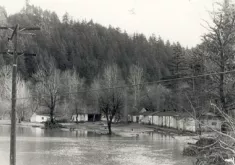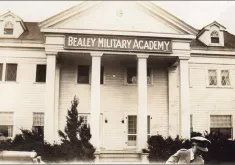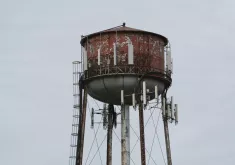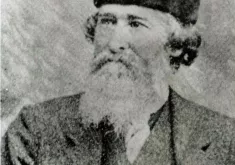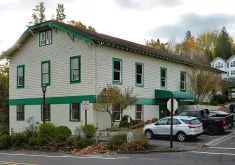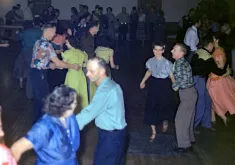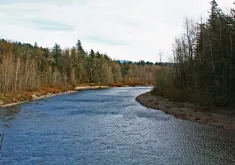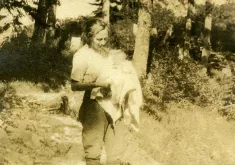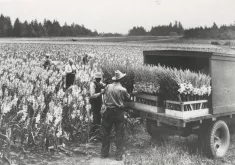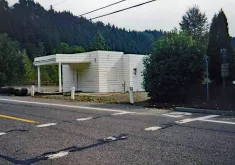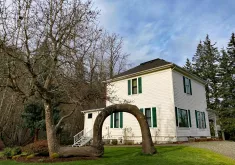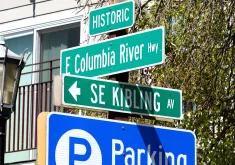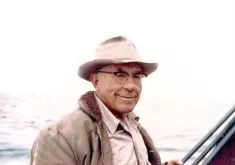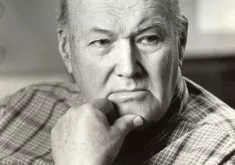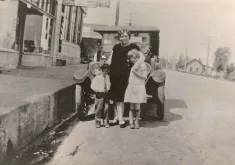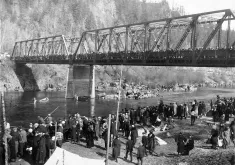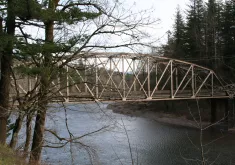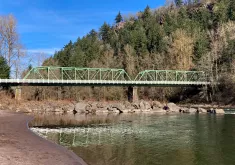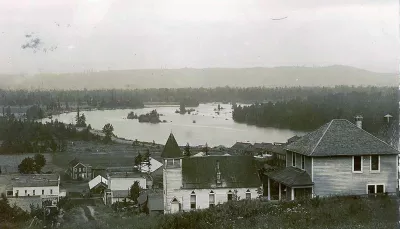
Troutdale’s history centers on the confluence of the Sandy and Columbia Rivers where Native Americans, English explorers, Hudson Bay Company fur trappers, and then Lewis and Clark were travelers.
The wetlands along the Columbia were hunting and fishing spots for Chinookan Indians once the spring floods eased. In the pools and ponds left behind, native people found fish, bird hunting and camas. Some artifacts were left behind and are in the care of the Troutdale and the Oregon historical societies.
From the British point of view, the Sandy River was "discovered" in October 1792, by Lt. William Broughton and his men in the armed tender “Chatham,” which was delegated to explore the Columbia by Capt. George Vancouver. Ascending the river, Broughton and his vessel reached a point just east of the mouth of the Sandy River, which he named Barings. Sighting Mount Hood for the second time on that voyage, he named the mountain after a British admiral. A rocky lava outcropping, immediately across the Sandy River from Troutdale, was later named Broughton Bluff.
The American overland expedition led by Meriwether Lewis and William Clark in 1804-1806, acknowledged Broughton’s name for the mountain, but renamed what is now the Sandy as the Quicksand on Nov.3, 1805. On their return while hunting in the area, the Americans learned from native residents that they had bypassed the Willamette River. Following a map drawn in the sand, they returned to explore the river. That trip would help open the way for overland travel to this area.
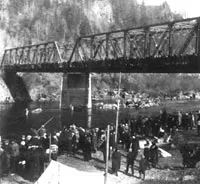
The earliest settlers to this area came in 1850 and 1851. Many landed at a small community, named Sandy, at the ferry landing at the mouth of the Sandy River. Early donation land claims were filed by John Douglass, D.F. Buxton, Benjamin Hall, James Stott and Felix Hicklin. Family records credit David F. Buxton as Troutdale's true founder because he filed an 1853 donation land claim in the center what is now Troutdale. Buxton developed the town's first primitive water system, which was in use until the 1960s. He died in Troutdale in 1910.
However, it was Capt. John Harlow, a former sea captain from Maine and successful Portland businessman, who conceived a plan for the town and made it happen. In 1872 he purchased part of Buxton's land claim to build a country home along the Sandy River. Because he raised trout in ponds on his farm, he called his farm "Troutdale." He seized the opportunity when a transcontinental railroad extended east from Portland through the Columbia River Gorge, to campaign for a depot so he could ship produce from his farm. On November 20, 1882, Troutdale had its depot and a stop on the rail line; an important step in becoming a bonafide town.
After Harlow's death in 1883, his widow, Celestia, platted a town on the hillside (later called Hungry Hill) with blocks and streets facing the railroad. Much of the new city was built in 1890 and 1891. The first edition of Troutdale's newspaper announced the opening of Aaron Fox's new store and a restaurant, and included ads for a hardware store, surgeon, notary public and blacksmith.
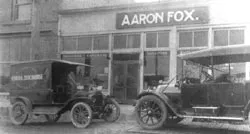
The town's major industry was the American Dressed Meat Company, later sold to become Portland's Swift and Company. Other industries that rose were a lumber mill, a hotel and a distillery. The distillery burned in what was reported as a "bright blue flame" in the 1890s.
Aaron Fox was instrumental in incorporating the city in 1907 and became its first mayor. It had become a town of saloons, and incorporation arose from the necessity to exercise controls over them. Huge licensing fees for the saloons precluded the need for city taxes.
In 1907, a disastrous fire swept through the city burning the 1890s buildings. A church built on a hillside two blocks from the business district, along with hillside houses, was among the buildings that survived.
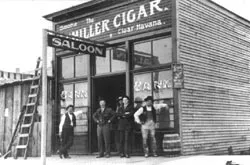
In 1912 women of Oregon got the right to vote. Two years later, Clara Latourell Larsson took office as mayor of Troutdale, becoming one of Oregon's earliest women mayors. The Columbia River Highway construction began in 1913, and its approach ran through Troutdale in 1916. Enterprising residents opened businesses, restaurants, tea rooms, hot dog stands, and dance pavilions to feed and entertain the travelers.
In 1924, Laura Harlow, daughter-in-law of John Harlow, was elected mayor of the city.
In 1925, a second fire again destroyed most of the business district. This fire is believed to have resulted from an explosion of a still in the garage of John Larsson, the former mayor's husband. The Tiller Hotel and Helming Saloon, both built after the first 1907 fire, survived the 1915 blaze. The Helming Saloon building still stands, adjacent to Mayor Square. Tiller’s Hotel was demolished.

John Harlow's original house was torn down in the 1920s. Remaining on the family property was the home his son, Fred, built in 1900 on the farm site. That building is now the Harlow House Museum of the Troutdale Historical Society. The original rail depot burned in 1907 and was replaced by a second depot that is now the Depot Museum. It was moved from its original location north of the Union Pacific rail line to its present site in 1979.
In the 1920s, Troutdale claimed the title of the "Celery Capital of the World" as a result of prize-winning celery grown here. But farmers also grew produce and gladiola bulbs in the area's fertile, sandy soil. Troutdale vegetables and later strawberries were shipped all over the nation by rail.
The Troutdale City Hall was completed by a citizen volunteer effort in 1922. The original wooden dance floor was the center of social life for years. Later the entire building was remodeled as city hall offices.
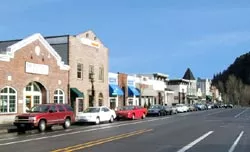
Construction of an aluminum plant to meet wartime needs was a boon to the economy in the mid 1940s and brought workers from all over the nation to work at what is now the industrial park. Eventually emissions from the plant ended the gladiola and other bulb industries and damaged other crops. Completion of Interstate 84 in the 1950s pulled traffic away from the Columbia River Highway and Troutdale. The City remained fairly quiet during the 1950s.
In the 1960s as Portland suburbs pushed east, Troutdale got its first subdivision, Weedin Addition. With growth coming, the city was required to build a sewage treatment plant by state agencies. Under the guidance of Mayor Glenn Otto, who later became a state senator and statewide leader, the city boundaries expanded from 320 to more than 2000 acres including the Multnomah County Farm and what was then a home for the disabled and aged.
Information supplied by the Troutdale Historical Society.

